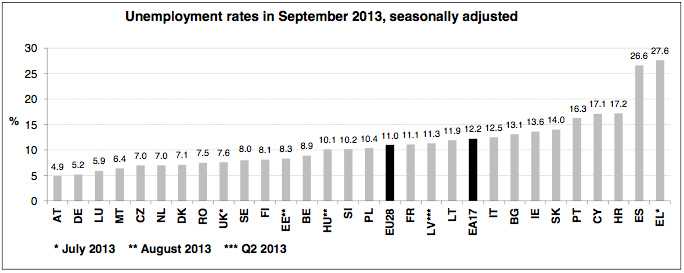US unemployment rose to 7.3% in October from 7.2% in September, according to the US Labor Department’s Bureau of Labor Statistics.
However, 204,000 new non-farm jobs were created, more than the 150,000 experts had expected.
The new report also informed that 60,000 more jobs had been added in September than the original report had suggested.
Economists had wondered what effect the 16-day government shutdown might have on unemployment figures.
The Labor Department said the higher unemployment rate was probably partly due to the shutdown – during this time hundreds of thousands of laid off federal workers were counted as unemployed.
What will the Fed do if US unemployment rose?
The US Federal Reserve says it will not start tapering its stimulus program of injecting $85 billion each month into the financial system until it sees more compelling economic growth and a clearer and steeper fall in unemployment.
Yesterday US authorities announced that GDP had grown by 2.8% (annualized) during the third quarter of 2013, of which 0.8% consisted of companies restocking their shelves. They also announced that consumer spending growth remained weak.
The Thomson Reuters/University of Michigan’s Survey of Consumer Sentiment for November dropped to 72, from 73.2 in October. Experts had expected a figure of more than 74 this month. Consumer sentiment is at its lowest point since December 2011.
Now that US unemployment rose, many see the Fed’s stimulus as prevailing well into 2014.
The BBC quoted Chief Economist at Markit, Chris Wiliamson, who said:
“The data will add to the view that the Federal Reserve is gearing towards a tapering of its asset purchases, but policymakers will most likely wait for clearer signs that the economy is capable of growing at a faster rate than seen in recent months, hoping to see a pace of economic growth that will eat into unemployment.”
At 7.3%, US unemployment is higher than Germany’s 5.2%, just below the UK’s 7.6%, and within the lowest quarter of the European Union. (Source: Eurostat)
Below are some highlighted data from the Labor Department for October 2013:
- Unemployment total: 11.3 million
- Unemployment rate: 7.3%
- Those on temporary layoff: an increase of 448,000 (includes furloughed federal employees)
- Adult males unemployed: 7%
- Adult females unemployed: 6.4%
- Teenagers unemployed: 22.2%
- Whites unemployed: 6.3%
- Blacks unemployed: 13.1%
- Hispanics unemployed: 9.1%
- Asians unemployed: 5.2%
There were 4.1 million people unemployed for at least 27 weeks (long-term unemployed). Long-term unemployment accounted for 36.1% of total unemployment.
US unemployment rose, but 190,000 jobs created each month over the year
Over the last 12 months, job growth averaged 190,000 per month. October saw gains in technical services and professional, health care, manufacturing, retail trade, and leisure/hospitality.
Leisure and hospitality created 44,000 new jobs in October, compared to a 12-month average of 31,000 per month.
The following sectors also saw more jobs created in October:
- Food and drink: +12,000
- Electronics and appliances stores: +10,000
- Sporting goods and hobby stores: +8,000
- General merchandise stores: +8,000
- Building material and garden supply stores: +7,000
A total of 13,000 jobs were lost in clothing and clothing accessories stores.
Technical and professional services added 21,000 jobs in October and 213,000 over the last 12 months. Within this sector 8,000 new jobs were created in management and technical consulting services last month.
A total of 19,000 jobs were created in manufacturing: 6,000 in motor vehicles and parts, 3,000 in wood products, and 3,000 in furniture and related products. However, the Labor Department adds that employment in manufacturing is about the same as it was in February 2013.
Health care create 15,000 new jobs. This sector has seen a 17,000 average job growth per month since January 2013, and 27,000 per month in 2012.
The number of federal civil servants dropped by 12,000 in October and 94,000 over the last 12 months.
The average working week in October stood at:
- 34.4 hours, the same as the month before for private non-farm workers.
- 40.9 hours in manufacturing, the same as in September.
- Factory overtime at 3.4 hours was the same as in September.
Hourly earnings in October for all non-farm private employees was $24.10, an increase of 2 cents compared to September. In production and non-supervisory jobs hourly pay was $20.26 in October, 2 cents up on September.

